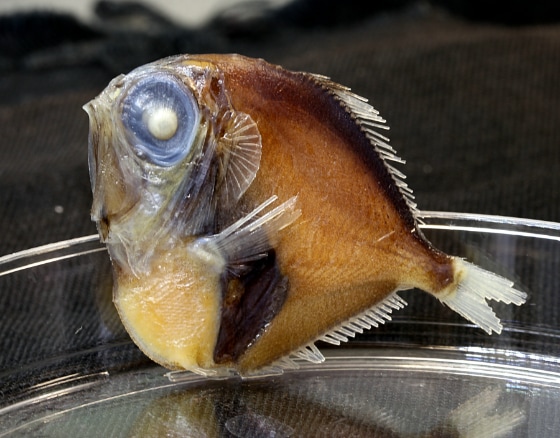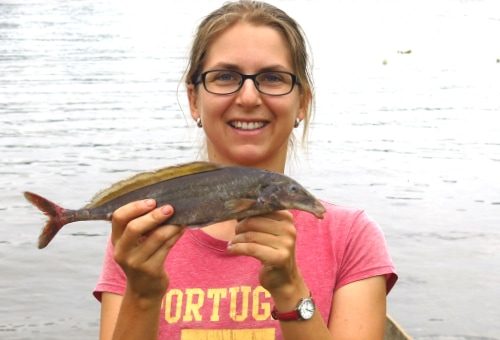How do some fish see color in the black-and-white world of the ocean’s depths? In episode 55, Zuzana Musilová, an evolutionary biologist at Charles University in Prague, discusses her research into the unique way that some fish in the deep ocean’s darkness may be able to see in color. Her article “Vision using multiple distinct rod opsins in deep-sea fishes” that was published with multiple coauthors on May 10, 2019 in Science. An open-access preprint is available on bioRxiv.
Websites and other resources
-
- Zuzana’s website and lab
- Article’s supplemental materials
- Charles University press release on Zuzana’s study
- A spiny silverfin (Diretmus argenteus) specimen, fixed (by Zuzana Musilova)

-
- Videos simulations of single rod photopigments in action
Zuzana describes the videos’ contents
Press and Media
New York Times | Popular Mechanics | Discover Magazine | CNET
Bonus Clips
Patrons of Parsing Science gain exclusive access to bonus clips from all our episodes and can also download mp3s of every individual episode.
Support us for as little as $1 per month at Patreon. Cancel anytime.
🔊 Patrons can access bonus content here.

We’re not a registered tax-exempt organization, so unfortunately gifts aren’t tax deductible.
Hosts / Producers
Ryan Watkins & Doug Leigh
How to Cite
Watkins, R., Leigh, D., & Musilová, Z.. (2019, August 9). Parsing Science – Fishing for Color. figshare. https://doi.org/10.6084/m9.figshare.9452402
Music
What’s The Angle? by Shane Ivers
Photo
Transcript
Coming soon!



Just three months after its publication, Zuzana and her team’s study has been covered by over 100 news outlets. We asked her what she thinks is responsible for the study’s popularity ... both to the media as well as the general public.@rwatkins says:
At least in humans, rods are responsible not only for night vision, but also our most sensitive motion detection, and our peripheral vision. Given the large number of rods possessed by silver spinyfins Ryan/ and I asked Zuzana if the fish might also have enhanced ability with these visual features as well.@rwatkins says:
Zuzana and her team computationally reconstructed the evolution of silver spinyfins’ vision and found that they first evolved an additional rhodopsin approximately 40 million years ago. The fish continued this genetic diversification about every 1-2 million years thereafter, resulting in the 38 rod opsins they now possess. Next, Zuzana explains why these gene duplications may have occurred, as well as how she and her team were able to determine this.@rwatkins says:
Zuzana and her team’s article mentions that silver spinyfins express more rhodopsin as adults than they do as larvae. This led us to wonder if an increase in gene expression is common among other animals as well.@rwatkins says:
Since such experimentation isn’t currently possible, Zuzana and her team developed five scenarios which could explain the proliferation of rhodopsin among these fish. First, each of the 38 photoreceptors might be tuned to different wavelengths of light, broadening vision in dimly-lit environments. Second, the photoreceptors might have an additive effect, deepening the fishs’ vision. Third, the long rods in the multibank retina could serve to filter the light reaching the other layers of rods. Fourth, they suggest that such filters have been predicted to enhance color discrimination or, at a minimum, contrast. Lastly, color vision may help to thwart bioluminescent camouflage, aiding in the identification of prey or even of potential mating partners. As it’s more common for researchers to report ”what” they found without venturing a guess as to “why” or “how” those phenomenon may exist, we asked Zuzana what led her and her team to develop these scenarios, as well as which among them she feels may have the greatest credence.@rwatkins says:
Given the difficulty of obtaining living specimens of spinyfins, we followed up by asking Zuzana what she thinks would be required to move forward with further experimentation, and whether or not doing experiments might help us develop a more definitive answer as to whether they’re able to discern color. We’ll hear what she had to say after this short break.@rwatkins says:
Megan Porter, who studies how vision evolved at the University of Hawaii at Mānoa, was quoted in the New York Times as saying that Zuzana’s study “goes against what we understood as how visual systems evolved in the deep sea, which means we have to question how visual systems work and function in the dim light." We asked Zuzana to elaborate on what she thinks that Porter might have meant by this.@rwatkins says:
Since we obviously have no way of asking spinyfins what their vision looks like, Ryan and I were interested in learning - if they do have color vision - whether it’s used, what their vision might be like, as well as for what reason they may have developed such an ability.@rwatkins says:
While Zuzana’s discovery of the spinyfins’ 38 different types of photoreceptors is a breakthrough in understanding their visual system, we’ve long known that the fish are unusual in that they have extremely long rods, and that these are layered. We were curious how this layering occurs, as well as what advantage it might provide to the fish.@rwatkins says:
Zuzana’s findings makes the spinyfin the vertebrate with the greatest number of visual opsins identified so far. We followed up by asking Zuzana to tell us more about what rhodopsins are, and how scientists estimate their influence on vision through computer simulations and laboratory experiments.@rwatkins says:
While Zuzana and her team discovered that several deep-sea fish appear to have the ability to see in color, one - the silver spinyfin - excelled in this regard. Doug and I were eager for her to describe what the fish looks like, where it lives, and what its development from larvae to adult is.@rwatkins says:
We can all probably recall that the eye works because of cones, which are responsible for color vision during daytime, and rods, which enable us to see in black and white during low-light conditions. But we weren't as likely to have learned about the biological process by which cones and rods work, which is via a group of proteins called “opsins.” There’s five classical groups of opsins, each attuned to a certain color of light. One of these, the opsin related to rods - called "rhodopsin" - is responsible for absorbing blue-green light and is the one that provides humans with the ability to see in low-light conditions. It's also the one that Zuzana and her team investigated. So we began our conversation by asking her to remind us how vision works, as well as to explain the role of rhodopsins in this process.